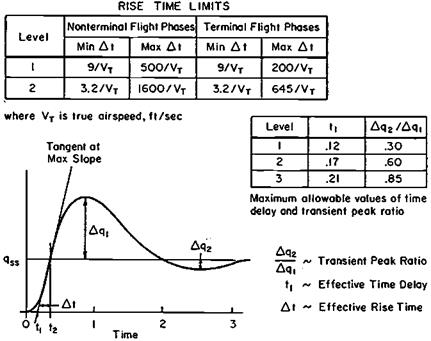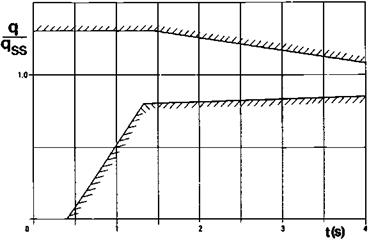Time Domain-Based Criteria
Time domain response specifications get around the need for equivalent systems. A standard time domain response form was used in the 1987 version of the U. S. flying
|
Figure 10.6 Example pitch attitude bandwidth/phase delay criterion, with test results. (From Field and Rossitto, 1999). |
|
Figure 10.7 Pilot evaluation of pitch response using Gibson Nichols chart template. (From Blight 1996) |
|
Figure 10.8 Generic pitch rate response to abrupt control input. This type of transient response description has the advantage of applying to high-order stability-augmented as well as unaugmented airplanes. (From Mil Standard MIL-STD-1797, 1987) |
qualities standard, MIL-STD-1797 (Figure 10.8). Other time domain response criteria have been proposed, as follows:
The C* Parameter L. G. Malcolm and H. N. Tobie originated the C* parameter, to blend normal acceleration and pitch rate responses to pitch control input. C* is actually a weighted, linear combination of the two responses, akin to the weighted performance indices used in optimization calculations.
The Time Response Parameter Some years later, C. R. Abrams enlarged on the C* parameter approach with a time response parameter that includes time delay in addition to the earlier normal acceleration and pitch rate terms.
Gibson Dropback Criterion This refers to the pitch attitude change following a commanded positive pulse in airplane angle of attack. Pitch attitude increases during the pulse. A pitch attitude decrease after the pulse ends is called a drop – back. A slight dropback is associated with fine tracking. A large or negative dropback (pitch overshoot) creates unsatisfactory pitch short-period behavior.
Special Time Response Boundaries Upper and lower boundaries for longitudinal response was a still later specification form, used widely for landing approach responses in addition to up-and-away flying. The space shuttle Orbiter’s longitudinal control response is governed by such boundaries (Figure 10.9), apparently established in simulation.
Gibson (2000) comments that the upper boundary in particular severely limits rapid acquisition of angle of attack change in response to pitch demand and was responsible for space shuttle touchdown problems. He says further:
|
Figure 10.9 An example of a time response boundary. The pitch rate response to a step-type manipulator input must lie between the boundaries. Pitch rate response q is normalized by the steady-state value qss. This particular time response boundary applies to the space shuttle Orbiter. (From Mooij, AGARD LS 157, 1988) |
The UK HOTOL project (a horizontal take off Shuttle equivalent) was studied at Warton.. .By designing to optimum piloted pitch response dynamics, i. e., with a rapid flight path response and hence considerable pitch rate overshoot, accurate automatic touchdown was easily achieved in simulation.
Further progress in understanding and improving longitudinal maneuverability has made use of closed-loop studies using the human pilot model (see Chapter 21).















